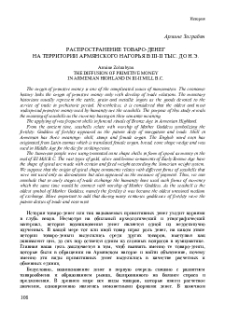Օբյեկտ
Վերնագիր: Распространение товаро-денег на территории Армянского нагорья в III-II тыс. до н.э.
Ամսագրի կամ հրապարակման վերնագիր:
Հրապարակման ամսաթիվ:
Համար:
ISSN:
ISBN:
Պաշտոնական URL:
Լրացուցիչ տեղեկություն:
Այլ վերնագիր:
The Diffusion Of Primitive Money In Armenian Highland In III-II Mill B.C.
Համատեղ հեղինակները:
Центр поддержки арменистических исследований. Москва
Աջակից(ներ):
Ծածկույթ:
Ամփոփում:
The origin of primitive money is one of the complicated issues of numismatics. The economic history links the origin of primitive money only with develop of trade relations. The monetary historians usually represent the cattle, grain and metallic ingots as the goods devoted to the service of trade in prehistoric period. Nevertheless, it is considered that the oldest and most widespread primitive money used by humanity are the seashells. The purpose of this study reveals the meaning of seashells as the currency basing on their semantic meaning. The applying of was frequent shells in funeral rituals of Bronze Age in Armenian Highland. From the ancient time, seashells relate with worship of Mother Goddess symbolizing the fertility. Goddess of fertility appeared as the patron deity of navigation and trade. Shell in Armenian has three meanings: shell, stamp and female organ. The English word coin has originated from Latin cannas which is translated female organ, bread, cone shape wedge and was used in Middle Age for the die for striking coins. The Sumerian people were using truncated cone shape shells in form of spiral as money in the mid of III Mill B.C. The vast types of gold, silver and bronze ornaments of Early Bronze Age have the shape of spiral are made with certain and fixed weight according the Sumerian weight system. We suppose that the origin of spiral shape ornaments relates with different forms of seashells that were not used only as decorations but also appeared as the measure of payment. Thus, we can conclude that in early stages of trade exchange the humanity have used such forms of currency whish the same time would be connect with worship of Mother Goddess. As the seashell is the oldest symbol of Mother Goddess, namely the fertility it was became the oldest uncoined medium of exchange. More important to add that during many centuries goddesses of fertility were the patron deities of trade and coin mint.
Հրատարակության վայրը:
Москва-Ереван-Степанакерт
Հրատարակիչ:
Ձևաչափ:
Նույնացուցիչ:
oai:arar.sci.am:338953
Լեզու:
Օբյեկտի հավաքածուներ:
Վերջին անգամ ձևափոխված:
Apr 15, 2024
Մեր գրադարանում է սկսած:
Jan 13, 2023
Օբյեկտի բովանդակության հարվածների քանակ:
28
Օբյեկտի բոլոր հասանելի տարբերակները:
https://arar.sci.am/publication/369397
Ցույց տուր նկարագրությունը RDF ձևաչափով:
Ցույց տուր նկարագրությունը OAI-PMH ձևաչափով։
-
Армянский гуманитарный вестник=Հայագիտական ուսումնասիրություններ. Պարբերագիր=Bulletin of Armenian Studies (Periodical Journal)
-
Армянский гуманитарный вестник, 2009, 2/3-I
- Обложка; Редакционная коллегия
- Содержание
- Армянско-русский словарь глагольных управлений (АРСГУ)
- Ковер из подземного царства
- Предание о ритуальном поясе
- Коммуникационная ось "Юг-Север" в системе внешних связей Армянского нагорья (I тыс. до н. э.)
- О происхождении армянского народа: проблема идентификации протоармян
- Хетто-цупанийские переселенцы и их боги на севере Урарту
- Распространение товаро-денег на территории Армянского нагорья в III-II тыс. до н.э.
- От мифологии ландшафта к историографии страны
- Об одном упоминании о белуджах у армянского хроника 18 века
- Армяно-византийские связи в области искусства с раннего средневековья до конца XI века
- Рубрикация как отражение литургии в декоративной системе армянских рукописных Евангелий
- Николай Адонц (1871-1942)
- О двух социально-политических терминах древнего Ближнего Востока: EWRI—„Владыко“ и PITIῌAS—(BITIAῌŠ) „Владетель или правитель области“
- Наши авторы
-
Армянский гуманитарный вестник, 2009, 2/3-II
-
Армянский гуманитарный вестник, 2012, 4
-
Армянский гуманитарный вестник, 2021, 7
-
Армянский гуманитарный вестник, 2022, 8 (Специальный выпуск)
-
Армянский гуманитарный вестник, 2022, 9
-
Армянский гуманитарный вестник, 2023, 10/1
-
Армянский гуманитарный вестник, 2023, 11/1 (Специальный выпуск)
-
Армянский гуманитарный вестник, 2023, 11/2 (Специальный выпуск)
-
Армянский гуманитарный вестник, 2009, 2/3-I
| Հրատարակության անուն | Ամսաթիվ |
|---|---|
| Зограбян, Армине, Распространение товаро-денег на территории Армянского нагорья в III-II тыс. до н.э. | Apr 15, 2024 |





